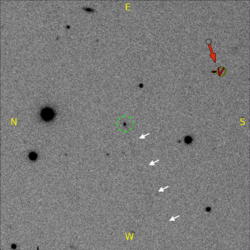Astronomy:(248370) 2005 QN173
 Cerro Tololo Observatory image of 2005 QN173 with a long, narrow tail (indicated with white arrows) on 22 July 2016 | |
| Discovery[1] | |
|---|---|
| Discovered by | NEAT |
| Discovery site | Palomar Observatory |
| Discovery date | 29 August 2005 |
| Designations | |
| 433P/(248370) 2005 QN173 | |
| 2005 QN173 | |
| Minor planet category | main-belt · (outer)[2] |
| Orbital characteristics[2] | |
| Epoch 25 February 2023 (JD 2460000.5) | |
| Uncertainty parameter 0 | |
| Observation arc | 22.05 yr (8,055 days) |
| |{{{apsis}}}|helion}} | 3.755 AU |
| |{{{apsis}}}|helion}} | 2.374 AU |
| 3.064 | |
| Eccentricity | 0.2254 |
| Orbital period | 5.36 yr (1,959 d) |
| Mean anomaly | 119.934° |
| Mean motion | 0° 11m 1.494s / day |
| Inclination | 0.068° |
| Longitude of ascending node | 174.334° |
| 145.860° | |
| Physical characteristics[2] | |
| Mean diameter | 3.599±0.214 km |
| Geometric albedo | 0.054 |
| C[3] | |
| Absolute magnitude (H) | 15.53[2] |
(248370) 2005 QN173 is a main belt asteroid that undergoes recurrent comet-like activity near perihelion,[4][5] and is now designated comet 433P/(248370) 2005 QN173.[6] This object was discovered on 29 August 2005 by the Near-Earth Asteroid Tracking program at Palomar Observatory.[1] It orbits in the outer main asteroid belt[7] with an orbital period of 5.36 years, a semi-major axis of 3.06 astronomical unit|AU, and an orbital eccentricity of 0.225, bringing it as close as 2.37 AU to the Sun at perihelion. The orbital plane is inclined at an angle of 0.068° to the ecliptic.[2]
On 7 July 2021, 2005 QN173 was found to be active by the Asteroid Terrestrial-impact Last Alert System survey.[6] Archival imagery showed it had been active during a previous perihelion passage,[8] dated 22 July 2016.[9] This indicates the activity is due to the sublimation of icy volatiles,[6] as is common with comets.[9] At the time that activity was identified, the object displayed a long, dusty tail, much like a comet. Follow up observations found this tail extended more than 9′ along its orbital plane.[7] By 14 August 2021, the coma around the nucleus was fading, while the brightness of the tail remained roughly constant.[6]
This asteroid has a diameter of 3.6±0.2 km, with a low visual albedo of 0.054±0.012. Its colors are consistent with a dark C-type carbonaceous asteroid taxonomic classification, which is class more commonly found in the outer main belt. Dust particles ejected from the object had very low velocities of about 1 m/s. This suggests that the dust emission may have been assisted by rapid spin of the asteroid, which would lower the escape velocity.[3]
The asteroid will make its next perihelion passage on 3 September 2026, and it may become active by February 2026.[3]
References
- ↑ 1.0 1.1 "(248370) = 2005 QN173". Minor Planet Center. https://www.minorplanetcenter.net/db_search/show_object?object_id=248370. Retrieved 2023-02-18.
- ↑ 2.0 2.1 2.2 2.3 2.4 "JPL Small-Body Database Browser: 248370 (2005 QN173)". Jet Propulsion Laboratory. https://ssd.jpl.nasa.gov/tools/sbdb_lookup.html#/?sstr=2248370. Retrieved 2023-02-18.
- ↑ 3.0 3.1 3.2 Hsieh, Henry H. et al. (November 2021), "Physical Characterization of Main-belt Comet (248370) 2005 QN173", The Astrophysical Journal Letters 922 (1): L9, doi:10.3847/2041-8213/ac2c62, L9, Bibcode: 2021ApJ...922L...9H.
- ↑ Planetary Science Institute (October 4, 2021), Is new finding an asteroid or a comet? It's both, https://phys.org/news/2021-10-asteroid-comet.html, retrieved 2023-02-18.
- ↑ Jefferson, Ron (October 6, 2021), "New Space Rock Hybrid Discovered Near Sun; Confirmed as Both Comet and Asteroid", The Science Times, https://www.sciencetimes.com/articles/33799/20211006/new-space-rock-hybrid-discovered-near-sun-confirmed-both-comet.htm, retrieved 2023-02-19.
- ↑ 6.0 6.1 6.2 6.3 Lister, Tim et al. (July 2022), "The LCO Outbursting Objects Key Project: Overview and Year 1 Status", The Planetary Science Journal 3 (7): 173, doi:10.3847/PSJ/ac7a31, 173, Bibcode: 2022PSJ.....3..173L.
- ↑ 7.0 7.1 Hsieh, Henry et al. (October 2021), "The Nucleus and Dust Tail of Active Asteroid (248370) 2005 QN173", Bulletin of the American Astronomical Society 53 (7), 2021n7i110p04, Bibcode: 2021DPS....5311004H.
- ↑ Chandler, C. O. et al. (July 26, 2021), Green, Daniel W. E., ed., "(248370) 2005 QN_173", Central Bureau for Astronomical Telegrams 5005, http://www.cbat.eps.harvard.edu/iau/cbet/005000/CBET005005.txt, retrieved 2023-02-17.
- ↑ 9.0 9.1 Chandler, Colin Orion et al. (November 2021), "Recurrent Activity from Active Asteroid (248370) 2005 QN173: A Main-belt Comet", The Astrophysical Journal Letters 922 (1): L8, doi:10.3847/2041-8213/ac365b, L8, Bibcode: 2021ApJ...922L...8C.
Further reading
- Masi, Gianluca (29 October 2021), "Comet 433P = Asteroid (248370) 2005 QN173 and its tail: new images – 12 Sept. and 27 Oct. 2021", The Virtual Telescope Project 2.0, https://www.virtualtelescope.eu/2021/10/29/comet-433p-asteroid-248370-2005-qn173-and-its-tail-new-images-12-sept-and-27-oct-2021/, retrieved 2023-02-19.
- Olason, Mike (8 October 2021), "Comet 433P", Sky & Telescope (AAS Sky Publishing, LLC), https://skyandtelescope.org/online-gallery/comet-433p/, retrieved 2023-02-19.
- Ivanova, Oleksandra et al. (September 2022), "Dust environment of active asteroid (248370) 2005 QN173", 16th Europlanet Science Congress 2022, held 18–23 September 2022 at Palacio de Congresos de Granada, Spain, doi:10.5194/epsc2022-203, EPSC2022-203, Bibcode: 2022EPSC...16..203I.
 |

